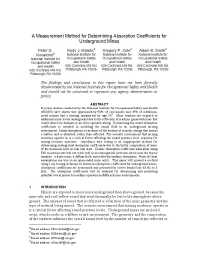Mining Publication: A Measurement Method for Determining Absorption Coefficients for Underground Mines
Original creation date: December 2006
Previous studies conducted by the National Institute for Occupational Safety and Health (NIOSH) have shown that approximately 90% of coal miners and 49% of metal/nonmetal miners had a hearing impairment by age 50. Mine workers are exposed to additional noise levels underground due to the reflection of machine generated noise that would otherwise dissipate in an above ground setting. Determining the sound absorption coefficients is essential in modeling the sound field in an underground mining environment. Sound absorption is a measure of the amount of acoustic energy that strikes a surface and is absorbed, rather than reflected. The acoustic environment that mining machines operate in is a critical factor affecting the sound pressure level exposure for mining machine operators. Impedance tube testing is an inappropriate method for determining underground absorption coefficients due to the brittle composition of some of the materials such as coal and slate. Classic absorption coefficient estimation using T60 measurements will not work well in an underground environment because the theory assumes: a finite room, a diffuse field, and relatively uniform absorption. None of these assumptions are true in an open-ended mine entry. This paper will present a method using a ray-tracing technique to determine absorption coefficients for underground mines. Absorption coefficients are determined and presented for octave bands from 63 Hz to 8 kHz. The absorption coefficients will be essential for determining and predicting potential overexposure to machine operators in different mine environments.
Authors: PG Kovalchik, RJ Matetic, GP Cole, AK Smith
Conference Paper - December 2006
NIOSHTIC2 Number: 20031467
Inter-Noise 2006. The 35th International Congress and Exposition on Noise Control Engineering, 3-6 December 2006, Honolulu, Hawaii. West Lafayette, IN: International Institute of Noise Control Engineering, 2006 Dec; :1-9
See Also
- The Development of a Damped Drill Steel to Reduce Roof Bolting Machine Drilling Noise
- Geologic Characterization
- Heavy Construction Equipment Noise Study Using Dosimetry and Time-Motion Studies
- Heavy Construction Equipment Noise Study Using Dosimetry and Time-Motion Studies
- Measurement Method for Determining Absorption Coefficients for Underground Mines
- Programmable Electronic Mining Systems: Best Practice Recommendations (In Nine Parts): Part 4: 3.0 Safety File
- Proximity Detection: A Continuing Research Imperative
- Proximity Warning Systems for Mining Equipment
- Refuge Alternatives in Underground Coal Mines
- Safe and Economical Inerting of Sealed Mine Areas
- Wireless Mesh Mine Communication System
- Page last reviewed: 9/21/2012
- Page last updated: 9/21/2012
- Content source: National Institute for Occupational Safety and Health, Mining Program


 ShareCompartir
ShareCompartir
